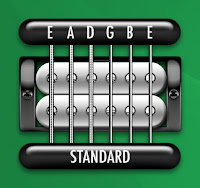--------------------
"Like an electric, the standard tuning for an acoustic guitar is E-A-D-G-B-E (low to high), where the pitch of each note is referenced to a standard pitch (A = 440.0Hz). However, the guitar is an easy instrument to change tunings with in order to create a whole new palate of sonic possibilities. These tunings can be placed into several subcategories, such as open tunings, lower tunings, higher tunings, dropped tunings and double drop tunings.
Open Tunings
Open tunings allow the guitarist to play a chord without any fretting, and has long been a favorite of the blues greats, especially those specializing in the slide guitar. You’ve heard Open G tuning, D-G-D-G-B-D, on many of the Rolling Stones hits including "Start Me Up," "Brown Sugar" and "Honkey Tonk Women." It was also a favorite tuning of Mississippi Delta bluesmen Son House, Charlie Patton and Robert Johnson.
Open A tuning, E-A-C#-E-A-E, was famously used by The White Stripes on "Seven Nation Army" (although that’s not acoustic), and Open D, D-A-D-F#-A-D, is favored by 60’s folk giant Richie Havens.
Another popular tuning, D-A-D-G-A-D, is sometimes called D modal or Celtic tuning. You’ve heard it on Led Zeppelin’s "Kashmir" and "Black Mountainside," and the Doobie Brothers’ "Black Water."
Drop Tunings
Drop tunings lower just the 6th string of the standard tuning, with Drop D being one of the most popular. Drop D is tuned as D-A-D-G-B-E and is used by Soundgarden ("Spoonman"), Creed ("Higher"), Radiohead ("Optimistic") and Led Zeppelin ("Moby Dick"). Drop C, C-G-C-F-A-D, would be a full step down from Drop D.
With double drop tunings, the 1st and 6th strings are dropped a full step, so Double Drop D is laid out as D-A-D-G-B-D. This was used by Neil Young on his hits "Cinnamon Girl," "When You Dance," "The Loner" and Crosby, Stills, Nash and Young’s "Ohio." Double Drop C, C-G-C-F-A-C, is a full step down from Double Drop D.
Lower Tunings
With lower tunings, all six strings are tuned down. An Eb tuning drops each string down a half-step and has been very popular with some of the greatest guitar players of our time such as Edward Van Halen, Stevie Ray Vaughn, Jimi Hendrix and Slash.
D tuning, D-G-C-F-A-D, where each string is tuned down a full step, is a favorite of John Fogarty, Dream Theater and the Nirvana hit "Come As You Are."
C tuning would be down two full steps to C-F-Bb-Eb-C-G, and has been used by Queens of the Stone Age and other metal bands. Tunings even lower are favored by Swedish death metal bands, but string tension will be quite low on some of these tunings, causing tuning and intonation problems.
High Tunings
Higher tunings, which are not used as much with acoustic guitars, will increase the string tension. F# tuning would be one full step up from standard with the strings at F#-B-E-A-C#-F# and G tuning (also sometimes called Third tuning) is G-C-F-A#-D-G. Not all acoustic instruments can handle these tunings, so it might be better to use a capo instead."
To read additional excerpts on this and my other books, check out the excerpts page on my website.
----------------------------------
Help support this blog. Any purchases made through our Amazon links help support this website with no cost to you.You should follow me on Twitter for daily news and updates on production and the music business.
Don't forget to check out my Music 3.0 blog for tips and tricks on navigating social media and the new music business.



5 comments:
Not exactly an alternate tuning but Nashville or high-strung tuning has been an incredibly useful tool for me in the studio (replacing the lowest four strings of an acoustic guitar with the octave strings from a 12-string set.) Indispensable!
"C tuning would be down two full steps to C-F-Bb-Eb-C-G, and has been used by Queens of the Stone Age"
I think the it should be C - F - Bb -Eb - G - C.
Thank you as usual :-)
Great stuff Bobby. Nothing like experimentation and thinking outside the circle to spice up one's creativity.
Looks like my Boss TU-2 will have a workout more than usual now...
Dear Bobby,
Blues guys love open tunings. I thought the blues guys had an interesting way of looking at them.
You mentioned open G and open A tunings. Blues guys sometimes called this "Spanish" tuning. I'm not sure why. It was "Spanish" for either chord I think because the interval between strings was the same. The open A tuning was just a whole step higher than open G. In addition to the guys you mentioned, Muddy Waters liked this tuning in his early days.
The other common tuning for blues guys was open D or open E. This was called "Vastapol." This is what Elmore James used. "Vastapol" is a corruption of "Sebastapol" which was the name of a Russian town located on the Black Sea. The town was burned down during the Crimean War I believe. Someone wrote a song about it, which was played in open D or E, and the song became synonomous with the tuning at some point.
Blues guys apparently learned to play slide from touring Hawaiian musicians in the early 20th century. Listen to Elmore James rock "Hawaiian Boogie" sometime!
Thanks for an always interesting blog Bobby.
Thanks for that, Fred. I know a lot about the blues from working with some of the greats, but those things I did not know.
Post a Comment